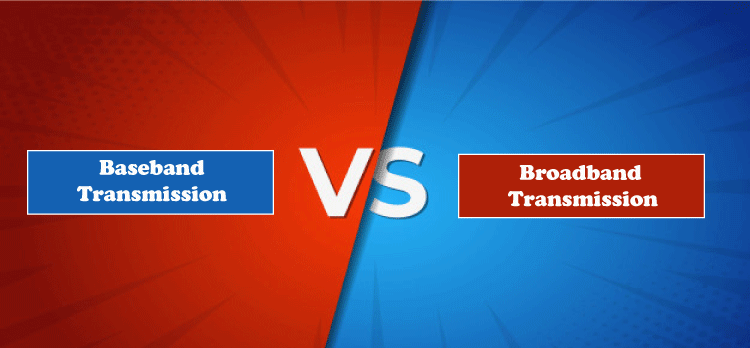Difference between Baseband and Broadband TransmissionBaseband and broadband are the two main types of signalling techniques. These terminologies were created to categorize various types of signals based on signal formats or modulation techniques. The broadband transmission sends many signals at once and utilizes analogue signals, whereas baseband transmission sends just one signal at a time and uses digital signals. In this article, you will learn about the difference between Baseband and Broadband transmission. But before discussing the differences, you must know about Baseband and Broadband transmission with their advantages and disadvantages. What is Baseband Transmission?It is a method of transmission where a single signal is either transmitted or received in the type of discrete pulses of a single frequency across a communication medium like a cable. The baseband signal's frequency is not changed, and the signal's bandwidth is almost 0. Baseband systems do not use frequency shifting, so only one signal uses the entire bandwidth of the system at once. Therefore, any remaining bandwidth is wasted. In this technology, several devices in a network interact with one another by sending and receiving data on a single communication channel that is shared by all connected devices and utilizing the channel's full bandwidth. The data is either transmitted or received at any time. All the devices in the network must be able to understand the same type of signal. However, Time Division Multiplexing (TDM) enables sharing of the same media. The baseband signal is frequently utilized in wired Local Area Networks (LANs) that are based on Ethernet. Advantages and Disadvantages of Baseband TransmissionThere are various advantages and disadvantages of baseband transmission. Some advantages and disadvantages of baseband transmission are as follows: Advantages
Disadvantages
What is Broadband Transmission?Broadband Transmission sends data in the form of analog signals, allowing signals to be sent at multiple frequencies simultaneously. This broadband transmission is unidirectional. In other words, the data is only transmitted in one direction at the same time. As a result, it may send or receive data but not perform both operations at the same time. Broadband transmission utilizes Frequency Division Multiplexing (FDM). The bandwidth in FDM is split into a number of frequency bands, each of which transmits a different signal. A multiplexer separates the numerous signals at the receiving end. It is typically more expensive to maintain and install due to the extra hardware involved. However, they cover more distance than baseband transmission. Broadband transmission is typically utilized via cable TV, several types of Digital Subscriber Lines (DSL), Asynchronous Transfer Mode (ATM), and Power Line communication. Advantages and Disadvantages of Broadband TransmissionThere are various advantages and disadvantages of broadband transmission. Some advantages and disadvantages of broadband transmission are as follows: Advantages
Disadvantages
Key differences between Baseband and Broadband Transmission
Here, you will learn about the key differences between Baseband and Broadband Transmission. Some of the main differences between Baseband and Broadband Transmission are as follows:
Head-to-head comparison between Baseband and Broadband TransmissionHere, you will learn the head-to-head comparisons between Baseband and Broadband Transmission. The main differences between Baseband and Broadband Transmission are as follows:
ConclusionThe two main categories of signalling are baseband and broadband transmissions. Baseband transmission utilizes the digital signal or electrical impulse that may be transported in a physical medium like wires. On the other hand, broadband transmission utilizes analogue signalling, which uses optical or electromagnetic wave signals. The baseband transmission utilizes the complete channel's bandwidth to broadcast a signal. In contrast, broadband transmission divides the channel's bandwidth into varying frequency ranges to transmit many signals simultaneously,
Next TopicDifference between
|
 For Videos Join Our Youtube Channel: Join Now
For Videos Join Our Youtube Channel: Join Now
Feedback
- Send your Feedback to [email protected]
Help Others, Please Share










